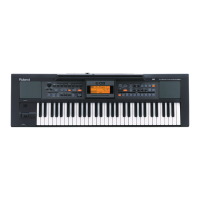
Do you have a question about the Roland E-09 and is the answer not in the manual?
| Polyphony | 64 voices |
|---|---|
| Display | Custom LCD |
| Weight | 5.5 kg |
| Power Supply | AC adaptor |
| Effects | Reverb, Chorus |
| MIDI | In, Out |
| Connectors | Output (L/Mono, R), Headphones, MIDI (In, Out), Pedal |
| Keyboard | 61 keys (with velocity) |
Details on preventing fire, electric shock, and injury, including warning and caution notices and symbol meanings.
Key safety precautions to follow during operation and placement of the unit.
Guidelines for power supply connections and optimal unit placement to prevent issues.
Instructions for cleaning, handling repairs, and backing up important data.
Further advice on handling, connecting, and operating the unit to ensure longevity and safety.
Identification and description of controls and connectors on the top and rear panels.
Instructions for installing the music rest on the unit.
Guidance on connecting external devices, foot switches, and the AC adaptor.
Procedures for powering the unit on and off, including initial setup steps.
Steps for properly powering down the instrument.
How to use demo songs, adjust display contrast, and reset the unit to factory settings.
Instructions for playing single tones, layered tones, and split keyboard configurations.
Methods for choosing tones, drum sets, and sound effects using various controls.
How to activate and adjust the metronome for practice.
Adjusting pitch via transposition, octave shifts, and custom keyboard scales.
Guide to activating the arranger, controlling tempo, sync start, and stopping playback.
Modifying the arranger's instrumental sound and balancing it with keyboard performance volume.
Choosing music styles and applying one-touch settings for instant sound configurations.
Overview of Melody Intelligence and how to change its harmony type.
Adjusting keyboard touch sensitivity, pitch bend, and modulation effects.
Connecting and using a foot switch, and selecting music assistant settings.
Saving and selecting user-defined instrument settings.
Introduction to effects and detailed steps for applying reverb.
Using chorus effects and multi-effects (MFX) for sound enhancement.
Descriptions of various Multi-Effects (MFX) types available on the unit.
Guide to recording performances using different modes like Rec All and Rec Keyboard.
Specific procedures for recording entire performances or just keyboard parts.
Methods for layering performances or re-recording specific song sections.
Instructions for playing songs, changing playback location, repeat playback, and minus-one playback.
General procedure for setting parameters and specific KBD SET options like Touch and Transpose.
Settings for metronome, octave adjustments for parts, and volume controls.
Parameters for arranger settings and various effect types (Reverb, Chorus, MFX).
Settings for keyboard scale, MIDI communication, and utility functions like LCD contrast.
Understanding MIDI channels and how to connect MIDI devices.
Detailed explanation of various MIDI transmission and reception parameters.
Procedures for transferring user programs and song data via MIDI (Bulk Dump/Load).
How to lock functions like Transpose, Tempo, Style, and Tone to maintain settings.
Solutions for problems related to power, no sound, and MIDI device connectivity.
Troubleshooting steps for effect application, pitch errors, distortion, and tempo problems.
Resolving problems with notes being cut off or sounding continuously.
List of Piano, Organ, and Guitar/Bass tones with their category and PC numbers.
List of Strings, Vocal, and Sax/Brass tones with their category and PC numbers.
List of Synth, World, and Drum tones with their category and PC numbers.
Overview of the different categories of drum sets available on the unit.
Detailed listing of drum sets from Program Change 1 to 60.
Detailed listing of drum sets from Program Change 61 to 128.
Comprehensive list of music styles categorized by genre, including tempo and time signature.
Visual representation of major, minor, seventh, and diminished chord voicings on the keyboard.
Visual representation of suspended, augmented, and other chord voicings on the keyboard.
Visual representation of jazz, blues, and world music chord voicings on the keyboard.
Chart detailing transmitted and recognized MIDI messages and their functions.
Technical details for keyboard, sound engine, arranger functions, and control elements.
Technical details for metronome, song controls, power supply, and included accessories.
Contact details for Roland service centers and distributors in Africa and Asia.
Contact details for Roland service centers and distributors in Australia, NZ, and Latin America.
Contact details for Roland service centers and distributors in Europe, Middle East, and North America.
